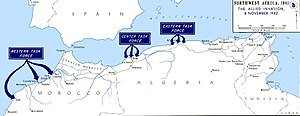
Back عملية الشعلة Arabic مشعل عملیاتی AZB Операция „Факел“ Bulgarian অপারেশন টর্চ Bengali/Bangla Oberiadur-brezel Torch Breton Operació Torxa Catalan Operace Torch Czech Operation Torch Danish Operation Torch German Επιχείρηση Πυρσός Greek
| Operation Torch | |||||||||
|---|---|---|---|---|---|---|---|---|---|
| Part of the North African campaign of the Second World War | |||||||||
 Landings during the operation | |||||||||
| |||||||||
| Belligerents | |||||||||
|
Naval only: |
| ||||||||
| Commanders and leaders | |||||||||
| Strength | |||||||||
|
Ground forces: 107,000 troops 35,000 in Morocco 39,000 near Algiers 33,000 near Oran Naval activity: 108 aircraft 350 warships 500 transports |
Ground forces: 125,000 troops 210 tanks 500 aircraft many shore batteries Naval forces: 1 battleship (partially armed) 10 other warships 11 submarines Germany: 14 submarines Italy: 14 submarines[3] | ||||||||
| Casualties and losses | |||||||||
|
United States: 526 dead United Kingdom: 574 dead All Other Allies: 756 total wounded[4] 1 escort carrier 4 destroyers lost 2 sloops lost 6 troopships lost 1 minesweeper lost 1 auxiliary anti-aircraft ship lost |
Vichy France: 1,346+ dead 1,997 wounded 1 light cruiser lost 5 destroyers lost 6 submarines lost 2 flotilla leaders lost Germany: 8 submarines lost by 17 November Italy: 2 submarines lost by 17 November[5] | ||||||||
Operation Torch (8–16 November 1942) was an Allied invasion of French North Africa during the Second World War. Torch was a compromise operation that met the British objective of securing victory in North Africa while allowing American armed forces the opportunity to begin their fight against Nazi Germany and Fascist Italy on a limited scale.[6] It was the first mass involvement of US troops in the European–North African Theatre and saw the first airborne assault carried out by the United States (by the 2nd Battalion, 509th Parachute Infantry Regiment).
The French colonies were aligned with Germany via Vichy France but the loyalties of the population were mixed. Reports indicated that they might support the Allies. The American General Dwight D. Eisenhower, supreme commander of the Allied forces in Mediterranean theater of the war, approved plans for a three-pronged attack on Casablanca (Western), Oran (Centre) and Algiers (Eastern), then a rapid move on Tunis to catch Axis forces in North Africa from the west in conjunction with the British advance from Egypt.
The Western Task Force encountered unexpected resistance and bad weather but Casablanca, the principal French Atlantic naval base, was captured after a short siege. The Centre Task Force suffered some damage to its ships when trying to land in shallow water but the French ships were sunk or driven off; Oran surrendered after bombardment by British battleships. The Eastern Task Force met less opposition and were able to push inland and compel surrender on the first day.
The success of Torch caused Admiral François Darlan, commander of the Vichy French forces, who was in Algiers, to order co-operation with the Allies, in return for being installed as High Commissioner, with many other Vichy officials keeping their jobs. Darlan was assassinated by a monarchist six weeks later and the Free French gradually came to dominate the government.
- ^ Opération Torch – Les débarquements alliés en Afrique du Nord
- ^ "Polish Ocean Liner MS Batory (Launched 1936) 2" Bronze Medallion w. Case | #1826031983".
- ^ I sommergibili dell'Asse e l'Operazione Torch.
- ^ Atkinson 2002, p. 159.
- ^ Granito and Emo. Navi militari perdute, Italian Navy Historical Branch, pp. 61–62.
- ^ Willmott 1984, p. 213.